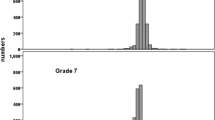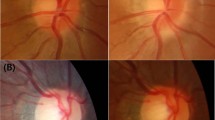Abstract
Purpose
To investigate the relationship between ocular biometrics (OB) and myopia onset.
Methods
OB data from students in 4 grades (aged from 6 to 14 years) in China were collected in a 1.5-year longitudinal study. Refractive error was assessed with cycloplegic autorefraction.
Results
At baseline, 934 (56.33%) of the subjects (right eye) had myopia. The mean spherical equivalent (SE) and axial length to corneal radius (AL/CR) were − 2.14 ± 1.49 and 3.14 ± 0.11, respectively, in the subjects with myopia and − 0.09 ± 0.21 and 2.98 ± 0.07, respectively, in the subjects without myopia. The correlation between the SE and AL/CR was r = − 0.823 (P < 0.001). The slopes of the SE changing with the AL/CR (and R-squares) were − 0.28 to − 1.80 (0.01–0.14) in the no myopia group, − 3.40 to − 6.20 (0.20–0.48) in the low myopia group, and − 3.37 to − 11.34 (0.16–0.74) in the moderate and high myopia groups. The baseline AL/CR values in grades 1, 3, and 5 were higher in those who developed myopia within 1.5 years. The odds ratio of the AL/CR to myopia onset in 1.5 years was 1.096 (95% confidence interval (CI): 1.060–1.135).
Conclusions
Of the five indicators, the AL/CR showed the best correlation with the SE. The adjoint and linear relationship between the AL/CR and the SE tended to increase with SE progression. When myopia progressed beyond a certain range, the AL/CR was significantly different in those without initial myopia who developed it within 1.5 years compared with those who did not. After adjusting for age, sex, school, and grade, the interpretation capability of the current AL/CR to myopia onset in 1.5 years was limited.





Similar content being viewed by others
References
Holden BA, Fricke TR, Wilson DA, Jong M, Naidoo KS, Sankaridurg P, Wong TY, Naduvilath TJ, Resnikoff S (2016) Global prevalence of myopia and high myopia and temporal trends from 2000 through 2050. Ophthalmology 123(5):1036–1042. https://doi.org/10.1016/j.ophtha.2016.01.006
Wang J, Ying G-s FX, Zhang R, Meng J, Gu F, Li J (2020) Prevalence of myopia and vision impairment in school students in Eastern China. BMC Ophthalmol 20. https://doi.org/10.1186/s12886-019-1281-0
Dong YH, Liu HB, Wang ZH, Yang ZP, Xu RB, Yang ZG, Ma J (2017) Prevalence of myopia and increase trend in children and adolescents aged 7-18 years in Han ethnic group in China, 2005-2014. Chin J Epidemiol 038(5):583–587. https://doi.org/10.3760/cma.j.issn.0254-6450.2017.05.005
Charman WN, Radhakrishnan H (2009) Accommodation, pupil diameter and myopia. Ophthal Physiol 29(1):72–79. https://doi.org/10.1111/j.1475-1313.2008.00611.x
Rabsilber TM, Becker KA, Frisch IB, Auffarth GU (2003) Anterior chamber depth in relation to refractive status measured with the Orbscan II Topography System. J Cataract Refract Surg 29(11):2115–2121. https://doi.org/10.1016/s0886-3350(03)00409-7
Richdale K, Bullimore MA, Sinnott LT, Zadnik K (2016) The effect of age, accommodation, and refractive error on the adult human eye. Optom Vis Sci 93(1):3–11. https://doi.org/10.1097/opx.0000000000000757
Zhao KK, Yang Y, Wang H, Li L, Wang ZY, Jiang F, Qu JF (2019) Axial length/corneal radius of curvature ratio and refractive development evaluation in 3- to 4-year-old children: the Shanghai Pudong Eye Study. Int J Ophthalmol 12(6):1021–1026. https://doi.org/10.18240/ijo.2019.06.23
Hashemi H, Khabazkhoob M, Miraftab M, Emamian MH, Shariati M, Abdolahi-Nia T, Fotouhi AJJoO, Research V (2013) Axial length to corneal radius of curvature ratio and refractive errors. Journal of ophthalmic & vision research 8:220–226
Jong M, Sankaridurg P, Naduvilath TJ, Li W, He M (2018) The relationship between progression in axial length/corneal radius of curvature ratio and spherical equivalent refractive error in myopia. Optom Vis Sci 95(10):921–929. https://doi.org/10.1097/opx.0000000000001281
Foo V, Verkicharla P, Ikram M, Chua S, Cai S, Tan CS, Chong Y-S, Kwek K, Gluckman P, Wong TY (2016) Axial length/corneal radius of curvature ratio and myopia in 3-year-old children. Transl Vis Sci Technol 5:5–5. https://doi.org/10.1167/tvst.5.1.5
Ma Y, Qu X, Zhu X, Xu X, Zhu J, Sankaridurg P, Lin S, Lu L, Zhao R, Wang L, Shi H, Tan H, You X, Yuan H, Sun S, Wang M, He X, Zou H, Congdon N (2016) Age-specific prevalence of visual impairment and refractive error in children aged 3–10 years in Shanghai, China. Investig Opthalmol Vis Sci 57:6188. https://doi.org/10.1167/iovs.16-20243
Choy BNK, You Q, Zhu MM, Lai JSM, Ng ALK, Wong IYH (2020) Prevalence and associations of myopia in Hong Kong primary school students. Jpn J Ophthalmol 64(4):437–449. https://doi.org/10.1007/s10384-020-00733-4
Wang J, Li Y, Zhao Z, Wei N, Qi X, Ding G, Li X, Li J, Song L, Zhang Y, Yi R, Ning Y, Zeng X, Hua N, Qian X (2020) School-based epidemiology study of myopia in Tianjin, China. Int Ophthalmol. https://doi.org/10.1007/s10792-020-01400-w
Thorn F, Chen J, Li C, Jiang D, Chen W, Lin Y, Chang X, Deng R, Chen Y (2020) Refractive status and prevalence of myopia among Chinese primary school students. Clin Exp Optom 103(2):177–183. https://doi.org/10.1111/cxo.12980
Wang D, Ding X, Liu B, Zhang J, He M (2011) Longitudinal changes of axial length and height are associated and concomitant in children. Invest Ophthalmol Vis Sci 52:7949–7953. https://doi.org/10.1167/iovs.11-7684
Yip V, Pan C-W, Lin X-Y, Lee YS, Gazzard G, Wong TY, Saw S-M (2012) The relationship between growth spurts and myopia in Singapore children. Invest Ophthalmol Vis Sci 53. https://doi.org/10.1167/iovs.12-10402
Flitcroft DI, He M, Jonas JB, Jong M, Naidoo K, Ohno-Matsui K, Rahi J, Resnikoff S, Vitale S, Yannuzzi L (2019) IMI – defining and classifying myopia: a proposed set of standards for clinical and epidemiologic studies. Investig Opthalmol Vis Sci 60(3). https://doi.org/10.1167/iovs.18-25957
Ostadimoghaddam H, Fotouhi A, Hashemi H, Yekta A, Heravian J, Rezvan F, Ghadimi H, Rezvan B, Khabazkhoob M (2011) Prevalence of the refractive errors by age and gender: the Mashhad eye study of Iran. Clin Exp Ophthalmol 39(8):743–751. https://doi.org/10.1111/j.1442-9071.2011.02584.x
Pi L-H, Chen L, Liu Q, Ke N, Fang J, Zhang S, Xiao J, Ye W-J, Xiong Y, Shi H, Yin Z-Q (2010) Refractive status and prevalence of refractive errors in suburban school-age children. International journal of medical sciences 7:342–353. https://doi.org/10.7150/ijms.7.342
Hashemi H, Pakzad R, Khabazkhoob M, Yekta A, Emamian MH, Fotouhi A (2020) Ocular biometrics as a function of age, gender, height, weight, and its association with spherical equivalent in children. Eur J Ophthalmol. https://doi.org/10.1177/1120672120908722
Saw S-M, Carkeet A, Chia K-S, Stone R, Tan D (2002) Component dependent risk factors for ocular parameters in Singapore Chinese children. Ophthalmology 109:2065–2071. https://doi.org/10.1016/S0161-6420(02)01220-4
He X, Zou H, Lu L, Zhao R, Zhao H, Li Q, Zhu J (2015) Axial length/corneal radius ratio: association with refractive state and role on myopia detection combined with visual acuity in chinese schoolchildren. PLoS One 10:e0111766. https://doi.org/10.1371/journal.pone.0111766
De Fauw J, Ledsam JR, Romera-Paredes B, Nikolov S, Tomasev N, Blackwell S, Askham H, Glorot X, O’Donoghue B, Visentin D, van den Driessche G, Lakshminarayanan B, Meyer C, Mackinder F, Bouton S, Ayoub K, Chopra R, King D, Karthikesalingam A, Hughes CO, Raine R, Hughes J, Sim DA, Egan C, Tufail A, Montgomery H, Hassabis D, Rees G, Back T, Khaw PT, Suleyman M, Cornebise J, Keane PA, Ronneberger O (2018) Clinically applicable deep learning for diagnosis and referral in retinal disease. Nat Med 24(9):1342–1350. https://doi.org/10.1038/s41591-018-0107-6
Wise J (2018) AI system interprets eye scans as accurately as top specialists. BMJ 362:k3484. https://doi.org/10.1136/bmj.k3484
Acknowledgments
We thank Yu Lin (Statistician, Shenzhen Withsum Technology Limited, supported by Shenzhen Science and Technology Plan, Grant No. CKCY20180323174659823) for assistance with data analysis that greatly improved the manuscript.
Funding
This study was financially supported by the Shenzhen Science and Technology Project (No. JCYJ20170306113900538), Sanming Project of Medicine in Shenzhen (No. SZSM201812090), and Shenzhen Nanshan Educational Science and Technology Fund (No. NSJY20170102).
Author information
Authors and Affiliations
Contributions
Hongwei Deng and Huahong Zhong conceived and designed the study. Yang Yu and Minjuan Zhu performed the data collection and organization. Zhengyang Tao, ShuiQiang Chen, and Shan Li analyzed the data. Zhengyang Tao wrote the paper. Hongwei Deng and Jun Zhao reviewed and edited the manuscript. All authors read and approved the manuscript.
Corresponding author
Ethics declarations
Statement of ethics
Parents and children were provided a clear and easy-to-understand explanation of the study. Any of the measurement results were recorded only with the informed consent of the parents. This study followed the Helsinki declaration and was approved by the institutional research ethics committee of Shenzhen Eye Hospital (L-2019-002).
Conflict of interest
The authors declare that they have no competing interests.
Additional information
Publisher’s note
Springer Nature remains neutral with regard to jurisdictional claims in published maps and institutional affiliations.
Rights and permissions
About this article
Cite this article
Tao, Z., Deng, H., Zhong, H. et al. A longitudinal study of the effect of ocular biometrics measures on myopia onset. Graefes Arch Clin Exp Ophthalmol 259, 999–1008 (2021). https://doi.org/10.1007/s00417-020-05010-1
Received:
Revised:
Accepted:
Published:
Issue Date:
DOI: https://doi.org/10.1007/s00417-020-05010-1




